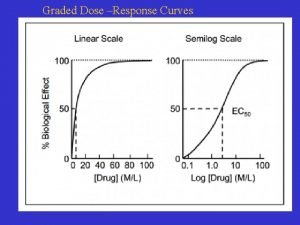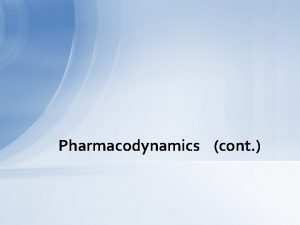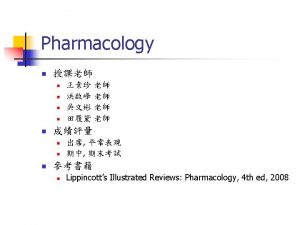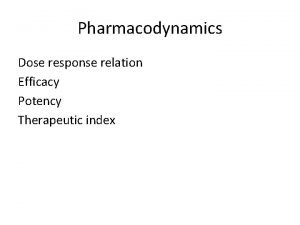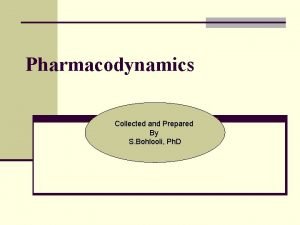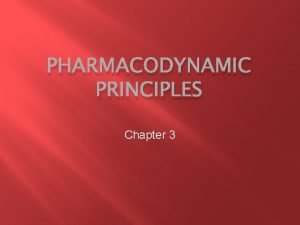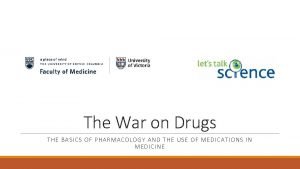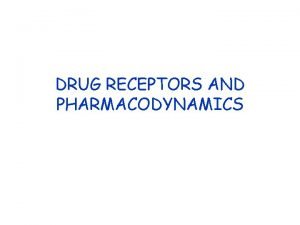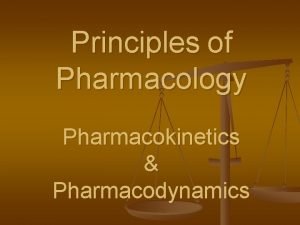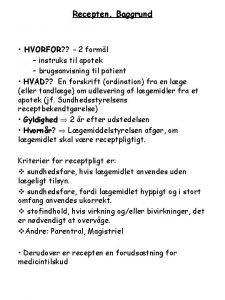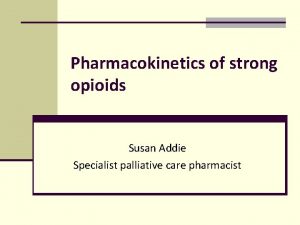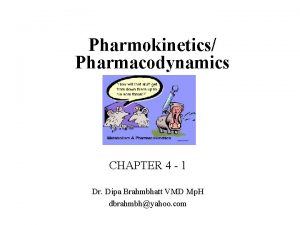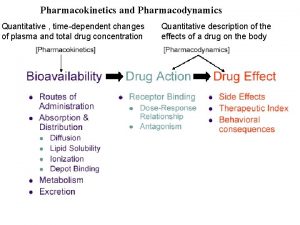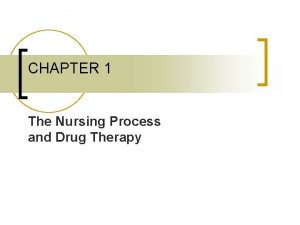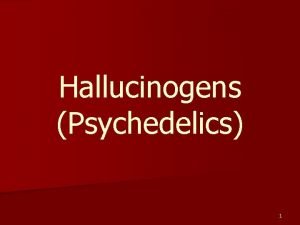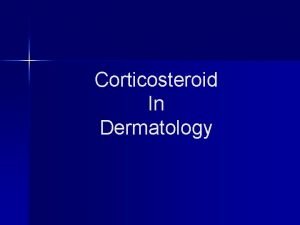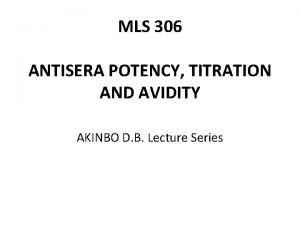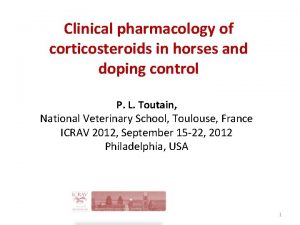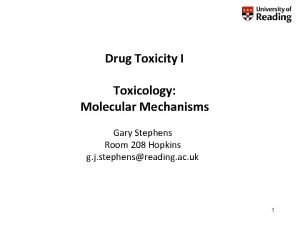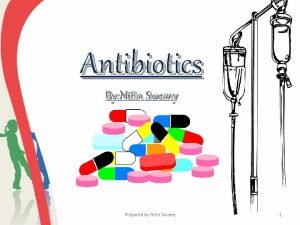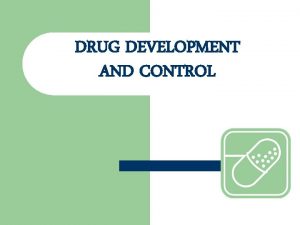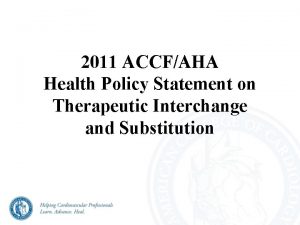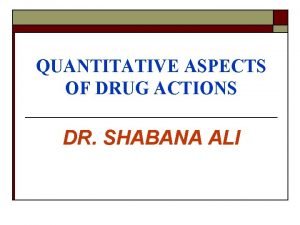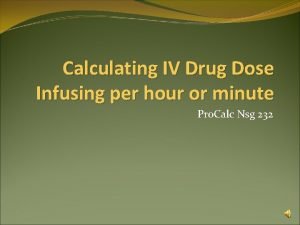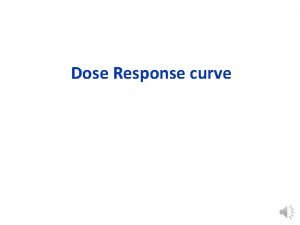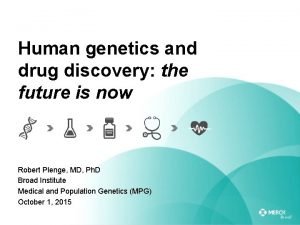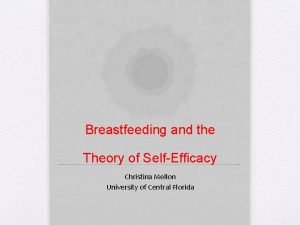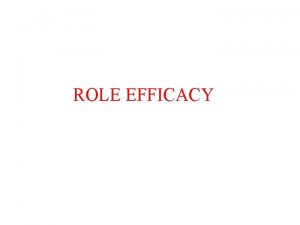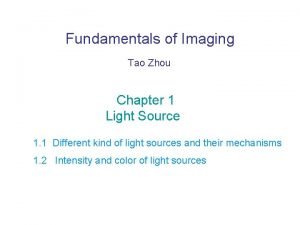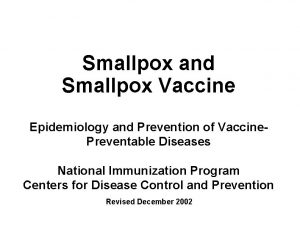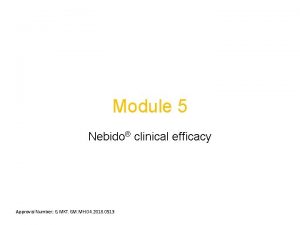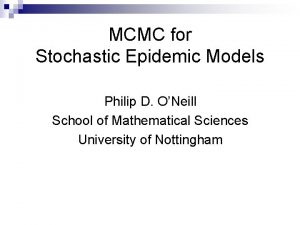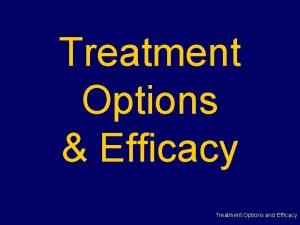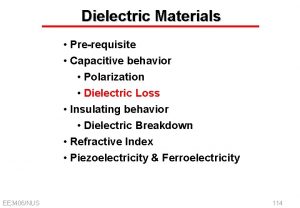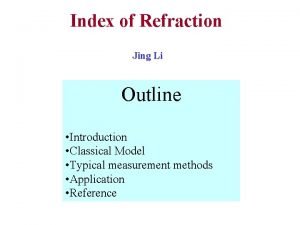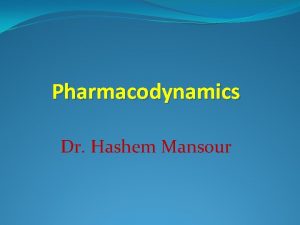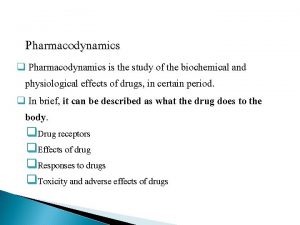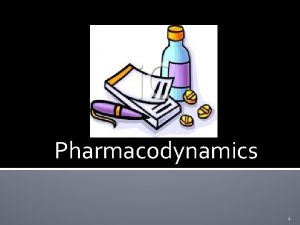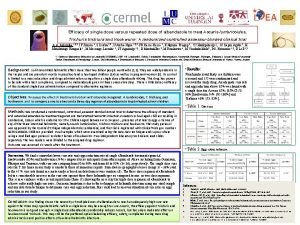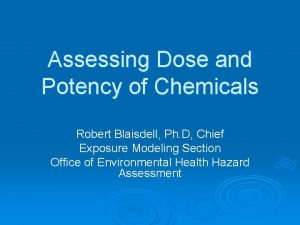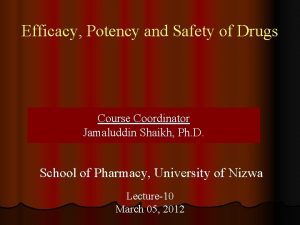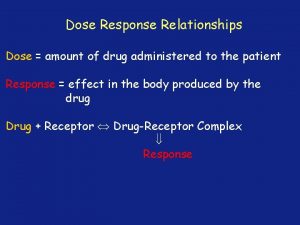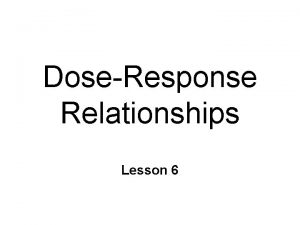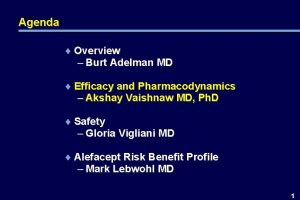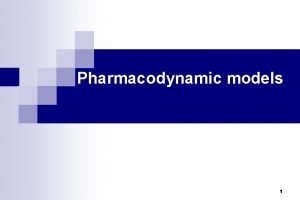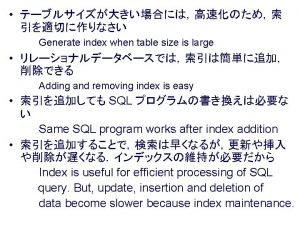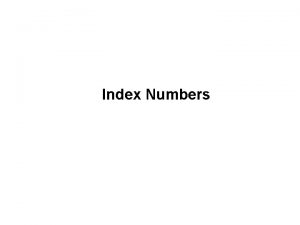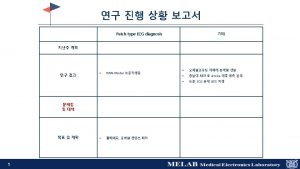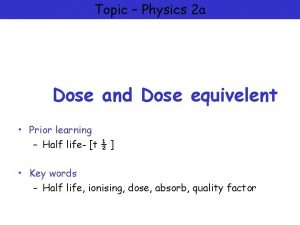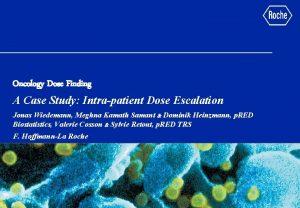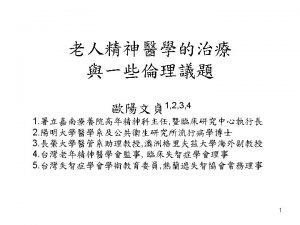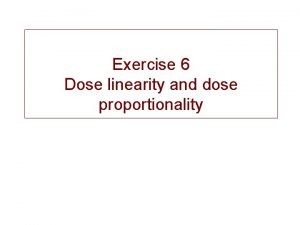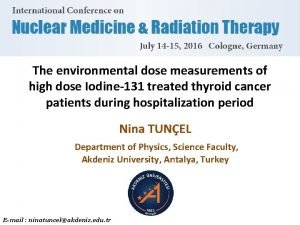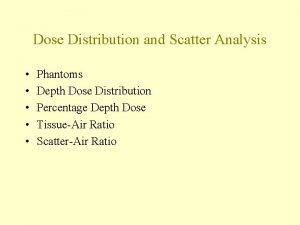Pharmacodynamics Dose response relation Efficacy Potency Therapeutic index

















































- Slides: 49

Pharmacodynamics Dose response relation Efficacy Potency Therapeutic index

PHARMACODYNAMICS What do drugs to the body?

To have a good fit to only one type of receptor; • Must be sufficiently unique in shape, charge and other properties • For selective binding, MW should be at least 100

Receptor: The component of a cell or organism that interacts with a drug and iniates the chain of events leading to the drug’s observed effects

Lippincott Illustration Reviews Pharmacology, 6 th edition

• Receptors largely determine the quantitative relations between dose or concentration of drug and pharmacological effects • Receptors are responsible for selectivity of drug action • Receptors mediate the actions of pharmacological agonists and antagonists

Agonist: binds to receptor and activates it, it brings directly/indirectly an effect Antagonist: binds to receptor, competes with and prevents binding by other molecules Partial agonist: bind to the same receptor as full agonists and activates them, but does not evoke as great response (even with high concentrations). May act either as an agonist or antagonist Inverse agonist: binds to receptor and reduces its constitutive activity

Lippincott Illustration Reviews Pharmacology, 6 th edition

Lippincott Illustration Reviews Pharmacology, 6 th edition

Potency • EC 50 (the dose of the agonist at which %50 of the effect is produced in presence of antagonist

Lippincott Illustration Reviews Pharmacology, 6 th edition

Lippincott Illustration Reviews Pharmacology, 6 th edition

Efficacy • Emax

Lippincott Illustration Reviews Pharmacology, 6 th edition

Katzung&Trevor Basic and Clinical Pharmacology, 13 th edition

Katzung&Trevor Basic and Clinical Pharmacology, 13 th edition

Lippincott Illustration Reviews Pharmacology, 6 th edition

Potency vs efficacy • Potent • Efficacious • Efficacy refers to the effect of a drug. The more effect the more efficacious the drug • Potency refers to the concentration of a drug needed for the effect. The less the concentration required, the more potent the drug

Therapeutic index Therapeutic Index: LD 50/ED 50 Therapeutic Index: TD 50/ED 50 Lippincott Illustration Reviews Pharmacology, 6 th edition

https: //medimoon. com/2014/12/therapeutic-window-and-therapeuticindex/? __cf_chl_jschl_tk__=b 64 fd 332 f 461472 fed 2 faf 8698915 d 26 d 8 cf 8 c 61 -1601643189 -0 -Aa. Dhxs. SO 7 LNirel. B 1 DKMXxr. Duq. PAWC 7 t. Lf. UOyv. W_JZ 5 c. Tk. Tjgu. Elis. Pg. LSIgc. MJ 1 Fb. W 7 i. Ax. OZyi 5 a. X 6 ms 7 t 0_9 y 7 Dy. AKe. Mc 8 IRik 7 gv 6 UK 8 JR 8 jpol 2 Q 5 FB 6 z. XJzbo 5 jg 3 CZAe. Rwq. KVmv. Vpi 0 K n. WKdq 42 ONg. V 2 Msl. Ik 0 Dvtc 6_3 HCZkd. T 379 b. Hu. Y 8 q. U-v. Eij. L 1 SCXr 1 rd_4 mr. DHV 4 N 0 Yr. K 4 df 9 Ult. WQYvm. Vx 51 AQxa. UCml. X 5 Fca 5 VOjw. Ln. YB 5 n 1_k. Sgvkqrhx 0 P 4 ib. GVq zgh. Y 7 r. SLlal. Gy. Mxs. Fvv. MRNHTERo. YHONY-o 6 xl. C 5 En. Sd 7 YOm. PYfw. UZ 9 Er. Y 7 r. Guc. I 8 e. YBU

Cumulative dose-reponse relation In the absence of spare receptors, EC 50 is equal to disociation constant of agonist-drug complex (Kd)

antagonism Competetive • Antagonist competes with the agonistfor the same binding site of the receptor • binding is reversible • Antagonism can be overcome by increasing concentration of agonist or vice versa • Parallel shift of curve to right with increasing concentration of antagonist but maximum response remains same

Katzung&Trevor Basic and Clinical Pharmacology, 13 th edition

p. D 2 • Measures the affinity of a noncompetetive as well as irreversible competetive antagonist for a spesific receptor • Defined as negative logarithm of the molar concentration of noncompetetive antagonist which will reduce the effect of an agonist to one half (%50) its maximum • p. D 2’=p. Dx+log[(E 1/2)-1] • p. Dx, negative molar concentration of the antagonist • E 1, E 2 max contraction heights in the absence and presence of antagonist

Noncompetetive antagonism • Irreversible (covalent bounds) • When the dose of antagonist is increased, maximal response of antagonist will decrease • In the presence of high doses of antagonist, no effect of agonist could be seen

Lippincott Illustration Reviews Pharmacology, 6 th edition

p. A 2 • Measure of the affinity of a reversible competetive antagonist for a spesific receptor • Defined as the negative log of molar concentration of the antagonist which will reduce the effect of double dose of the agonist drug to that of a single dose • p. A 2=-log KB

Quantal dose response curve • Like a drug used to the pain • Either no effect (zero effect) • Or pain relieved (max effect)

Katzung&Trevor Basic and Clinical Pharmacology, 13 th edition

• ED 50: the dose of the drug required to achieve half of the expected response • TD 50: the dose of the drug required to achieve toxicity in half of the subjects given the drug • LD 50: the dose of the drug required to be lethal to half of the subjects given the drug • t 1/2: half life, the amount of time required to lower the concentration for the drug by half

Signaling mechanisms Drug Action

Receptors • Regulatory proteins • Enzymes (dihydrofolate reductase, receptor for methotrexate) • Transport proteins( Na+-K+-ATPase, a receptor for digitalis glycosides) • Structural proteins (tubulin, a receptor for colchicine)

Receptors are responsible for selectivity of drug action

Orphan receptors • Their ligands are presently unknown (Farnesoid X receptor, Liver X receptor…)

Lippincott Illustration Reviews Pharmacology, 6 th edition

Lippincott Illustration Reviews Pharmacology, 6 th edition

Lippincott Illustration Reviews Pharmacology, 6 th edition

Lippincott Illustration Reviews Pharmacology, 6 th edition

Katzung&Trevor Basic and Clinical Pharmacology, 13 th edition

Katzung&Trevor Basic and Clinical Pharmacology, 13 th edition

Katzung&Trevor Basic and Clinical Pharmacology, 13 th edition

Katzung&Trevor Basic and Clinical Pharmacology, 13 th edition

Katzung&Trevor Basic and Clinical Pharmacology, 13 th edition

Katzung&Trevor Basic and Clinical Pharmacology, 13 th edition

Katzung&Trevor Basic and Clinical Pharmacology, 13 th edition

Katzung&Trevor Basic and Clinical Pharmacology, 13 th edition

Katzung&Trevor Basic and Clinical Pharmacology, 13 th edition

Katzung&Trevor Basic and Clinical Pharmacology, 13 th edition

Katzung&Trevor Basic and Clinical Pharmacology, 13 th edition
 Graded response curve
Graded response curve Potency vs efficacy
Potency vs efficacy Efficacy potency
Efficacy potency Potency vs efficacy
Potency vs efficacy Iontropic
Iontropic Pharmacodynamics
Pharmacodynamics Pharmacodynamics
Pharmacodynamics Pharmacological antagonist
Pharmacological antagonist Difference between pharmacodynamics and pharmacokinetics
Difference between pharmacodynamics and pharmacokinetics Recepten
Recepten Pharmacokinetic definition
Pharmacokinetic definition Pharmacodynamics
Pharmacodynamics Pharmacokinetics vs pharmacodynamics
Pharmacokinetics vs pharmacodynamics Define pharmacodynamics
Define pharmacodynamics Cubensis potency chart
Cubensis potency chart Ddo quality potency
Ddo quality potency Steroid potency
Steroid potency Potency requirements in an antiserum
Potency requirements in an antiserum Beclomathasone
Beclomathasone Therapeutic index
Therapeutic index Therapeutic index
Therapeutic index Define therapeutic index
Define therapeutic index Therapeutic substitution vs interchange
Therapeutic substitution vs interchange High therapeutic index
High therapeutic index Competitive and non competitive antagonist
Competitive and non competitive antagonist High therapeutic index
High therapeutic index Graded dose response curve
Graded dose response curve Graded dose response curve
Graded dose response curve Dose-response
Dose-response Apes chapter 11
Apes chapter 11 Drug efficacy
Drug efficacy Christina mellon
Christina mellon Albert bandura self-efficacy
Albert bandura self-efficacy Role efficacy
Role efficacy Luminous efficacy comparison chart
Luminous efficacy comparison chart Collective teacher efficacy
Collective teacher efficacy Vaccine efficacy
Vaccine efficacy Testosterone injection dosage chart
Testosterone injection dosage chart Drug efficacy
Drug efficacy Collective teacher efficacy
Collective teacher efficacy Vaccine efficacy
Vaccine efficacy Optimal self confidence
Optimal self confidence Efficacy therapy
Efficacy therapy Collective teacher efficacy
Collective teacher efficacy Measuring personality in organisational behaviour
Measuring personality in organisational behaviour Permittivity refractive index relation
Permittivity refractive index relation Complex refractive index
Complex refractive index First order system transfer function
First order system transfer function A subsequent
A subsequent Natural and forced response
Natural and forced response
